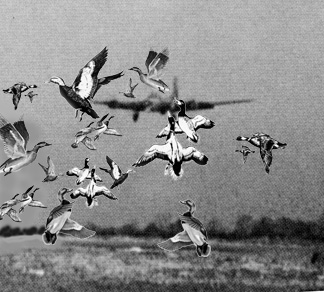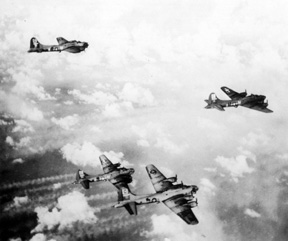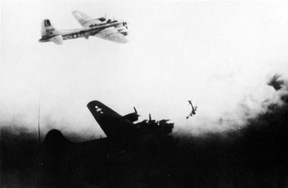|
B-29 Emergency Mobile Repair and Test Flight Crewmember by Art Jones |
||||||||||||
 |
 |
|||||||||||
|
Second Hand Stories Wounded in Action My friend Len Melvin, he of banana weight gain, returned from his war time service at about the same time of my discharge. During the years of playing bridge, going to parties and just being very good young married friends, we swapped many of our individual experiences. What follows are some of my pal Leonard's exploits. The 8th Air Force was one of the prime American forces that pulverized the Third Reich. During the flights from Bases in England, the Flying Fortresses were targets of every aerial destructive device the Germans could develop. The sole purpose of a flight was to drop bombs on the enemy at places planned to do the most damage to the enemy's war potential. Lt. Melvin was a Bombardier who used the super-secret Norden Bomb Sight to aim his B-17 airplane so the bombs would hit the enemy's air bases, industrial sites, and whatever else was on the flight plan of the day. Each crew strived to make the fifty missions that was considered enough to be sent home for Stateside duty. The Purple Heart medal, instigated by George Washington in 1782, was issued to servicemen who were wounded in action of some kind while performing their duties. Mel had such an award, but his story of how it came about had a different twist than anyone might surmise. |
||||||||||||
| His plane was a part of one of the B-17 squadrons placed into action over Germany quite early in the course of the War in Europe. The English country side was dotted with landing fields and hangars for the Allied bombers. On the return from one of their missions, Len's plane was lined up for landing and flew through a flock of ducks. The plexiglas window in the front of the Bombardier's seat was smashed by the fowl impact. Lt. Melvin was gashed across his cheek by a sharp edged piece of the shattered pane. |
||||||||||||
 |
||||||||||||
|
He was taken to a nearby hospital and stitched up. The loss of blood he incurred necessitated a delay of his returning to duty by two days. He did receive the Purple Heart because of his wound which after all DID HAPPEN during a combat situation.
The mission he couldn't go on was the one in which his plane was shot down over German Territory. Thereby lies another story Len didn't learn the details of until the Prisoners of War were released and he and his crewmates were reunited before being sent home for discharge. Editor's Note: Doing it “By The Book” |
||||||||||||
| The Flying Fortress had dropped its load on the German Industrial complex from a high altitude. The substitute Bombardier who was taking the injured Lt. Melvin's place was thankful he had found what seemed to be the only hole in the clouds over the entire country.
Shortly after they turned around to head for their Base in England, antiaircraft fire severely damaged the plane. Two of the crew members were killed by shrapnel and the burning aircraft was spiraling down in a column of black smoke. The “bail out” order had been given and the last man on board was the pilot in the cockpit seat. He pulled the escape hatch release above his head and was ready to dive out when two physical facts about being a B-17 pilot suddenly dawned on him. The backpack style parachute worn by the pilots was normally placed in their seats and the straps with the buckles slopped over the sides of the upright section. Because of the extreme cold of the high altitudes flown, the pilots were issued electric heated boots so their feet would not become so numb they couldn't operate the foot controls. The regular issue uniform boots were always tied together by the strings and placed on the floor beside their owners. |
||||||||||||
 |
||||||||||||
|
Photos from Great American bombers of WW II, ctsy. William N. Hess Below: A Fortress from the 452nd Bomb Group begins its long earthward fall. USAAF photo |
||||||||||||
 |
||||||||||||
|
Here are the thoughts and actions of the pilot as he got ready to leave the crippled plane and after he did leave it.
“My God, I can't jump without my parachute. But I can reach down with my left arm and pull the strap up on my shoulder until I'm clear.” Then, “Good Lord, there's no way I can walk halfway across Germany in these felt boots. I'll grab those boot strings with my right hand.” He did exactly as planned, and squirmed out of the escape opening to be thrown clear of the wreckage by the spin of the airplane. There he was, falling rapidly from an altitude the height of which he had no real knowledge because of the confusion caused by the direct hits and bailout procedures that had happened since he had last looked at an altimeter. “I can't get this chute on and buckled with these damn boots in my hand. Hell!, I won't need them if I don't get this chute buckled on.” So he released the boots, struggled into the parachute straps and snapped the buckles closed. When he got ready to deploy his chute he looked up and was surprised to see the boots had been falling with him and were within arm's reach. They were recovered as his thought patterns went like this. “Those German bastards have been strafing our guys when they are hanging defenseless after bailing out. I'll not pull the ripcord until I get into those clouds where they can't see me”. In a moment the vapor of the clouds obscured his vision and he knew no German Fighter was going to butcher him as he came down. But then, “I don't know how close to the ground the clouds are situated -- here goes the rip-cord.” The pop of the parachute opening was just moments before he landed in the middle of what seemed like a clover field. All combat crew members were trained in the procedures to follow if they ever were downed by the enemy. These instructions also followed as thoughts and actions when the pilot landed through the overcast in the field. “Gather up the chute into as small a wad as you can.” He did. He was escorted to the nearest Prison Camp where he spent the rest of his wartime career. End of Page 4, Chapter 4 — Go to Page 5 Or you may go to Cover Page — Introductions — Table of Contents Or you may go to Home - Contact Us - Cold War Hist. - 91st SRS Hist. - Stardust 40 Mission Story |
||||||||||||